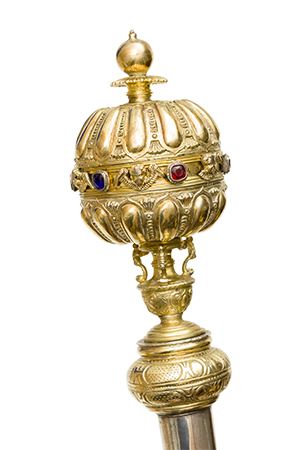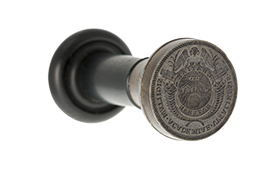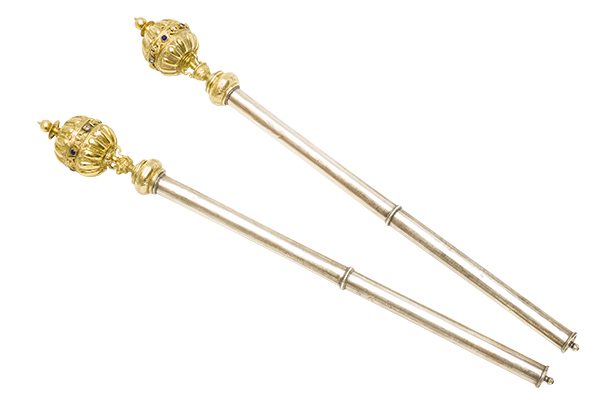In the past, the succession ceremony for Vice-Chancellors was the most frequent ceremony at the University because the role of Vice-Chancellor was rotated every semester between the University’s professors. But since 1876, the Vice-Chancellor has been appointed for several years at a time and so the succession ceremony has become a rarer occurrence.
As part of the succession ceremony, the outgoing Vice-Chancellor hands over the insignia of the Vice-Chancellor’s office – its symbols of power and responsibility – to their successor. The insignia are the sceptres, the seal, keys, charters, the student register and the Vice-Chancellor’s chain of office.
 The sceptres
The sceptres
Uppsala University has two sceptres. The oldest was used at the very first Conferment Ceremony on 22 January, 1600, and the second was made a year or so later. They are not entirely identical, but can be difficult to distinguish from one another at a distance. The round gold crown of the sceptres were a gift of then Duke, and later King Karl IX to the University. They were made in the late Renaissance style without any pictorial symbols. The Uppsala University sceptres are in fact Sweden's oldest preserved academic ritual objects.
The sceptres are symbols of the University’s self-rule. Up until the mid-19th century, the universities in Uppsala and Lund had their own jurisdictions. This meant that University employees and students were subject to the University’s laws and were indicted and sentenced by the University for breaches of these laws. It was also the University that meted out any punishment applicable to breaches of these laws. So in the past, Uppsala University had its own prison.
The succession ceremony where the outgoing Vice-Chancellor hands over the symbols of the office to their successor is the only time the Vice-Chancellor holds both sceptres. The University’s sceptres are normally borne in front of the Vice-Chancellor in processions.
 The seal
The seal
The University’s seal has the Latin inscription “Gratiae veritas naturae”. This can be translated as “Truth through the grace of God and through nature”. The seal started to be used widely in the mid-17th century and actually became so worn that a new one was made in the late 18th century. The new seal from the 18th century is the one handed over at the succession ceremony.
The keys
In the past, real keys were handed over to the new Vice-Chancellor. These keys were to the treasury, the archives, and the prison. Today instead, two symbolic gold-plated keys from the 18th century are handed over during the succession ceremony.
The University’s charters and the student register
At the succession ceremony, two books are handed over which serve to symbolise two key but different parts of the University. The 1655 års konstitutioner (1655 Charters) symbolise the legal foundation on which the University rests and the oldest volume of the student register Album studiosorum from the end of the 16th century symbolises the students.
The Vice-Chancellor’s chain of office
If Uppsala University has the oldest sceptres in Sweden, what about the Vice-Chancellor’s chain of office? Well, as you might have guessed, the Uppsala University Vice-Chancellor’s chain of office is also the oldest in Sweden – although it is just on 300 years younger than the sceptres.
The chain of office was gifted to the University by Oscar II in 1877 for the University’s 400th anniversary. The medallion in the chain also shows Oscar II’s image. The chain includes four faculty symbols that also serve as links, one for each of the faculties that existed at the University in 1877: the Faculty of Theology, the Faculty of Law, the Faculty of Medicine, and the Faculty of Philosophy.
In more modern times, in 1998 to be precise, Uppsala University also acquired a Deputy Vice-Chancellor’s chain of office that can be worn by the Deputy Vice-Chancellor. Interestingly, this chain can also be worn by the Vice-Chancellor – but only on trips away from the University. The Deputy Vice-Chancellor's chain of office was a gift from Anders Wall, an honorary fellow of the University.
A worn out symbol
Vice-Chancellors at other universities often have a ceremonial robe. Is this something that Uppsala University has missed out on? In fact in the past Uppsala University also had a robe for its Vice-Chancellor to wear at ceremonies. But it was worn out by the 19th century and no new ceremonial robe has been procured.
